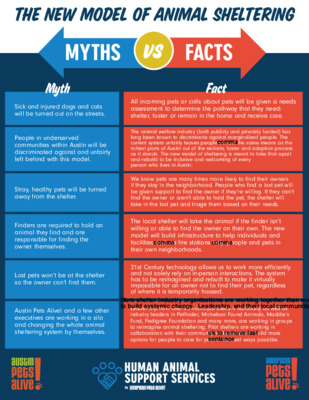Jefferson HASS Myths Facts — original pdf
Backup

comma comma comma More shelter industry organizations are working together than ever before to build systemic change. Leadership, and their local communities, from... ok to remove last sentence Sick and injured dogs and cats will be turned out on the streets.All incoming pets or calls about pets will be given a needs assessment to determine the pathway that they need: shelter, foster or remain in the home and receive care. Stray, healthy pets will be turned away from the shelter.We know pets are many times more likely to find their owners if they stay in the neighborhood. People who find a lost pet will be given support to find the owner if they’re willing. If they can’t find the owner or aren’t able to hold the pet, the shelter will take in the lost pet and triage them based on their needs.Finders are required to hold an animal they find and are responsible for finding the owner themselves.The local shelter will take the animal if the finder isn’t willing or able to find the owner on their own. The new model will build infrastructure to help individuals and facilities such as fire stations help people and pets in their own neighborhoods. Lost pets won’t be at the shelter so the owner can’t find them.21st Century technology allows us to work more efficiently and not solely rely on in-person interactions. The system has to be reimagined and rebuilt to make it virtuallyimpossible for an owner not to find their pet, regardless of where it is temporarily housed. Austin Pets Alive! and a few other executives are working in a silo and changing the whole animal sheltering system by themselves.Leadership from over 30 municipal shelters nationally, as well as industry leaders in Petfinder, Michelson Found Animals, Maddie’s Fund, Pedigree Foundation and many more, are working in groups to reimagine animal sheltering. Pilot shelters are working in collaboration with their community stakeholders to build more options for people to care for pets in the best ways possible.People in underservedcommunities within Austin will be discriminated against and unfairly left behind with this model.The animal welfare industry (both publicly and privately funded) has long been known to discriminate against marginalized people. The current system unfairly leaves people without the same means as the richest parts of Austin out of the reclaim, foster and adoption process as it stands. The new model of sheltering is meant to take that apart and rebuild to be inclusive and welcoming of every person who lives in Austin.FACTSMYTHSvsThe new model of animal shelteringMythFact